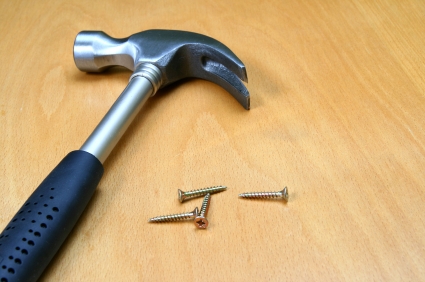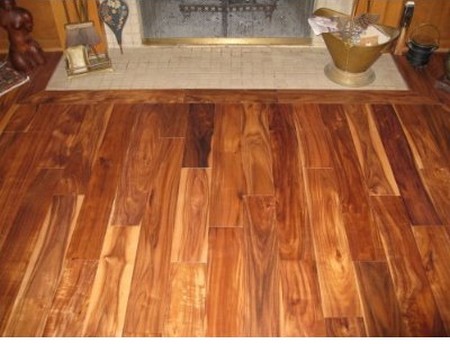Where you want to use a solid floor as a basis for a floor covering, ensure that it is sound, dry and level. Usually, it is possible to make repairs to a solid floor to bring it up to scratch; in extreme cases, it may be necessary to dig it up and lay a new floor.
REPAIRING THE SURFACE
Minor cracks in a solid floor can be ignored, but any large cracks or holes will need to be filled. This is a fairly simple task provided the floor is basically dry.
The crack or hole should be cleaned up and all loose material removed. If necessary, widen the crack to allow better penetration of the filler. To ensure good adhesion of the filler, prime the crack or the inside of the hole with a mixture of 1 part PVA adhesive/sealer and 5 parts water. Then mix up a mortar filler, consisting of 3 parts sand, 1 part cement (or use a quick-setting dry ready-mix mortar) and equal parts of PVA bonding agent and water. Apply the filler with a pointing trowel, pushing it well into the crack or hole. Deep holes may need filling in more than one layer; trowel over the top surface to smooth out the filling mortar.
Some solid floors suffer from ‘dusting’ – a tendency to be covered with a layer of dust which keeps on reappearing despite regular brushing. To prevent this cover the floor with a dilute solution of PVA adhesive/sealer or a special concrete sealer.
LEVELLING A SOLID FLOOR
With some floor coverings, such as vinyl sheeting, it may not worry you that the floor undulates or slopes from one side to the other. But with other floor coverings, such as woodstrip flooring or many kinds of tiles, unevenness will be very noticeable once the covering is laid and the floor should be levelled before you start.
This is achieved with a special floor levelling compound which is spread out on the floor with a trowel to a maximum depth of 3 mm. Before you start, the floor should be thoroughly cleaned with a mixture of sugar soap and water and large holes and cracks filled with mortar and allowed to set; holes up to 5 mm will be filled by the self-levelling compound.
The floor should be dampened before the levelling compound is laid and the compound itself mixed with water in a bucket until it forms a kind of slurry. Smooth it out as flat as possible with a trowel; it will level itself and the trowel marks will disappear. You can normally walk on the floor after about two hours and the floor covering can be laid after about eight hours.
Skirting boards (baseboards) should be removed before floor levelling compound is used and replaced afterwards. You may need to trim a small amount off doors which open into the room so they clear any new floor covering that has been laid over the newly levelled surface. Take these off before you start the job and check them before replacing.
DAMP-PROOFING A FLOOR
Dampness on a floor can be caused by one of two things – rising damp coming up from underneath or condensation, which is the result of warm moist air in the room meeting the cold floor surface. There is a simple test you can do to tell the difference, which is to invert a glass container on a ring of putty laid on the floor surface and leave it there for a couple of days. If water droplets collect on the underside of the glass container, the problem is rising damp; if they collect on the outer surface, the problem is condensation.

If the answer is rising damp and it is not too serious, the problem can be solved by painting or brushing two or more coats of a rubberized bitumen compound on the floor surface. This will act as a damp-proof membrane over which to lay your new floor covering. Remove the skirting boards (baseboards) and make sure that the bitumen compound is ‘painted’ up the walls as well as forming a continuous surface across the floor. A more serious rising damp problem indicates that there is no existing damp-proof membrane further down (common with older ‘brick-on-earth’ floors) and the only real answer is to dig the floor up and start again -a major undertaking.
If the problem is condensation, it would still be a good idea to use a rubberized bitumen compound, but you should also use a floor covering which has some insulation properties (such as cushioned vinyl or floor coverings containing cork). These will make the surface warmer than, say, using quarry tiles. At the same time take other measures to reduce the amount of moisture in the air such as fitting extractor fans in kitchens.
